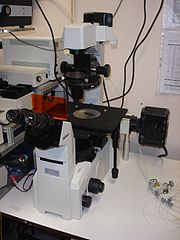
Inverted microscope
Encyclopedia


Microscope
A microscope is an instrument used to see objects that are too small for the naked eye. The science of investigating small objects using such an instrument is called microscopy...
with its light source and condenser on the top, above the stage pointing down, while the objectives
Objective (optics)
In an optical instrument, the objective is the optical element that gathers light from the object being observed and focuses the light rays to produce a real image. Objectives can be single lenses or mirrors, or combinations of several optical elements. They are used in microscopes, telescopes,...
and turret are below the stage pointing up. It was invented in 1850 by J. Lawrence Smith, a faculty member of Tulane University
Tulane University
Tulane University is a private, nonsectarian research university located in New Orleans, Louisiana, United States...
(then named the Medical College of Louisiana).
Inverted microscopes are useful for observing living cells
Cell (biology)
The cell is the basic structural and functional unit of all known living organisms. It is the smallest unit of life that is classified as a living thing, and is often called the building block of life. The Alberts text discusses how the "cellular building blocks" move to shape developing embryos....
or organism
Organism
In biology, an organism is any contiguous living system . In at least some form, all organisms are capable of response to stimuli, reproduction, growth and development, and maintenance of homoeostasis as a stable whole.An organism may either be unicellular or, as in the case of humans, comprise...
s at the bottom of a large container (e.g. a tissue culture
Tissue culture
Tissue culture is the growth of tissues or cells separate from the organism. This is typically facilitated via use of a liquid, semi-solid, or solid growth medium, such as broth or agar...
flask) under more natural conditions than on a glass slide, as is the case with a conventional microscope.
Inverted microscopes are also used in micromanipulation
Micromanipulator
A micromanipulator is a device which is used to physically interact with a sample under a microscope, where a level of precision of movement is necessary that cannot be achieved by the unaided human hand...
applications where space above the specimen is required for manipulator mechanisms and the microtools they hold, and in metallurgical applications where polished samples can be placed on top of the stage and viewed from underneath using reflecting objectives.
The stage on an inverted microscope is usually fixed, and focus is adjusted by moving the objective lens along a vertical axis to bring it closer to or further from the specimen. The focus mechanism typically has a dual concentric knob for coarse and fine adjustment.
Depending on the size of the microscope, four to six objective lenses of different magnifications may be fitted to a rotating turret known as a nosepiece. These microscopes may also be fitted with accessories for fitting still and video cameras, fluorescence illumination
Fluorescence microscope
A fluorescence microscope is an optical microscope used to study properties of organic or inorganic substances using the phenomena of fluorescence and phosphorescence instead of, or in addition to, reflection and absorption...
, confocal scanning
Confocal laser scanning microscopy
Confocal laser scanning microscopy is a technique for obtaining high-resolution optical images with depth selectivity. The key feature of confocal microscopy is its ability to acquire in-focus images from selected depths, a process known as optical sectioning...
and many other applications.

